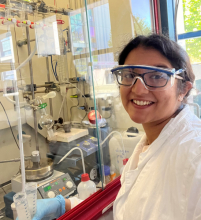
University:
Major:
Site Abroad:
Mentor(s):
Faculty Sponsor(s):
Faculty Sponsor's Department:
Project Title:
Project Description:
Upconverting, lanthanide-doped nanoparticles can convert low-energy photons (e.g., from the near infrared) into visible light. Their luminescence is strongly temperature-dependent, which makes the particles suitable as components for thermometric materials. These materials are appealing for temperature measurements with high accuracy, nanoscale spatial resolution, and fast temporal response in applications ranging from biomedicine to photovoltaics.
While red and green upconverting emitters with high quantum efficiency have been reported, blue emitting particles are less efficient as they have not been optimized in terms of synthetic protocols. In addition, their thermometric performance is relatively poor. Therefore, within this project, we focused on blue emitting lanthanide doped materials. We synthesized NaYF4 host nanoparticles with cubic and hexagonal crystal structures using solvothermal routes. X-ray diffraction and transmission electron microscopy characterization techniques were used to confirm the phases and understand particle morphologies, respectively. Afterwards, these hosts were doped with varying concentrations of Tm3+ ions. Photoluminescence data demonstrated that the cubic crystalline structure of the NaYF4 host with 0.5 mol% Tm3+ ions maximized the intensity of the blue emission.
The performance of the blue emitting particles as nanothermometers was evaluated using relative thermal sensitivity based on the fluorescence intensity ratio (FIR) model. The relative thermal sensitivity for the single blue emitter was very low, below 0.30% K-1, which led to poor thermometric performance. To improve their performance, we synthesized different types of fluorescent materials and mixed them in equimolar concentrations with the blue emitting particles since the mixed emitters displayed a significantly higher relative thermal sensitivity compared to the blue emitters alone.
Finally, we prepared fluorescent nanocomposites using polylactic acid as a polymer. This polymer is widely utilized in 3D printing technologies and is biodegradable, allowing us to explore novel fluorescent sensor applications in the future.
